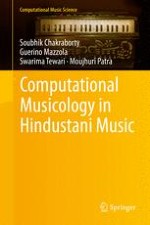2014 | OriginalPaper | Buchkapitel
7. Modeling Musical Performance Data with Statistics
verfasst von : Soubhik Chakraborty, Guerino Mazzola, Swarima Tewari, Moujhuri Patra
Erschienen in: Computational Musicology in Hindustani Music
Aktivieren Sie unsere intelligente Suche, um passende Fachinhalte oder Patente zu finden.
Wählen Sie Textabschnitte aus um mit Künstlicher Intelligenz passenden Patente zu finden. powered by
Markieren Sie Textabschnitte, um KI-gestützt weitere passende Inhalte zu finden. powered by
